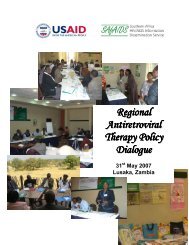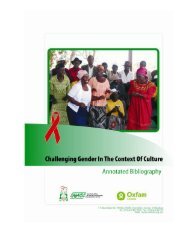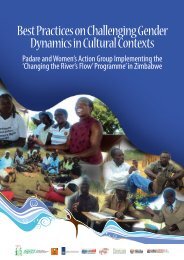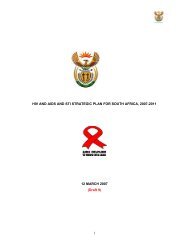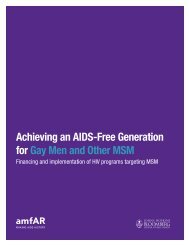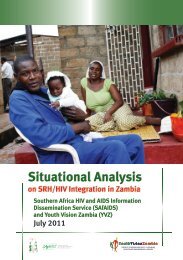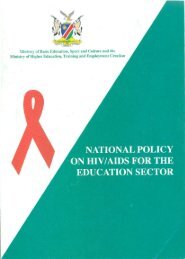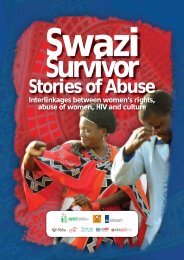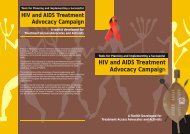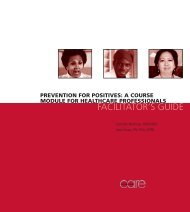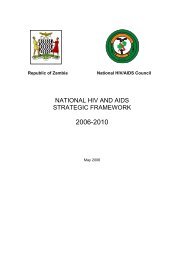Implementation of regional and international HIV prevention - SAfAIDS
Implementation of regional and international HIV prevention - SAfAIDS
Implementation of regional and international HIV prevention - SAfAIDS
- No tags were found...
You also want an ePaper? Increase the reach of your titles
YUMPU automatically turns print PDFs into web optimized ePapers that Google loves.
10.0 LESSONS LEARNT IN IMPLEMENTATION OFAGREED CONVENTIONS10.1 Positive lessons learntSwazil<strong>and</strong> <strong>and</strong> Zambia have demonstrated their commitment to be guided by major<strong>international</strong> conventions that guide <strong>HIV</strong> <strong>and</strong> AIDS responses. The two countries are signatoriesto the following conventions, declarations <strong>and</strong> protocols: the Abuja Call For Accelerated ActionTowards Universal Access to <strong>HIV</strong> <strong>and</strong> AIDS, Tuberculosis <strong>and</strong> Malaria Services in Africa; the AbujaDeclaration <strong>and</strong> Framework for Action for the Fight Against <strong>HIV</strong>/AIDS, TB <strong>and</strong> other relatedInfectious Diseases in Africa; the Convention on the Elimination <strong>of</strong> All Forms <strong>of</strong> DiscriminationAgainst Women (CEDAW) <strong>and</strong> the Gaborone Declaration on a Roadmap Towards UniversalAccess to Prevention.The two countries are also signatory to the Maputo Resolution on Acceleration <strong>of</strong> <strong>HIV</strong>Prevention in Africa, the Millennium Development Goals (MDG); the New Partnership forAfrica’s Development (NEPAD); OAU Assembly Declaration on AIDS Epidemic in Africa; thePolitical Declaration <strong>and</strong> Further Action on Beijing Declaration <strong>and</strong> Platform for Action; theUnited Nations General Assembly Special Session on <strong>HIV</strong>/AIDS (UNGASS), <strong>and</strong> the SADCDeclaration on <strong>HIV</strong> <strong>and</strong> AIDS.Both Governments have put in place policies <strong>and</strong> frameworks for domestication <strong>of</strong> these<strong>international</strong> conventions <strong>and</strong> protocols. However, Zambia has not made any deliberateattempt to put in place a legal framework that specifically addresses the various protocolsto which the country is signatory. The following are some <strong>of</strong> the key achievements <strong>and</strong>challenges faced by the two countries in the implementation <strong>of</strong> conventions, declarations<strong>and</strong> protocols.10.1.1 Specific lessons from Swazil<strong>and</strong>Swazil<strong>and</strong>’s UNGASS report for 2008 shows that the country has made considerable efforts in<strong>prevention</strong>, care <strong>and</strong> support. Swazil<strong>and</strong> undertook a number <strong>of</strong> <strong>HIV</strong> <strong>prevention</strong> efforts, suchas VCT, condom promotion, IEC, PMTCT <strong>and</strong> blood safety. Achievements under <strong>prevention</strong>include development <strong>of</strong> a national policy on blood safety in 2000 <strong>and</strong> the adoption <strong>of</strong> nationalguidelines by 2001. The percentage <strong>of</strong> donated blood screened for <strong>HIV</strong> with an external qualityassurance scheme is 100%.48Having developed its first PMTCT guidelines in 2002, <strong>HIV</strong> testing among pregnant womenincreased from 15% in 2004 to 66% in 2006. The percentage <strong>of</strong> <strong>HIV</strong> positive pregnant womenunder the PMTCT programme was 62% in 2006 <strong>and</strong> 64.8% in 2007. The country is on course toreach its committed target <strong>of</strong> 80% by 2010. (Universal Roads Access to Prevention, Treatment<strong>and</strong> Care <strong>and</strong> Support in Swazil<strong>and</strong>, November 2007).Swazil<strong>and</strong> achieved the WHO ‘3 by 5’ target <strong>of</strong> 13,000 patients on ART by 2005. Currently, 35% <strong>of</strong>persons with advanced <strong>HIV</strong> infection are receiving ART (children: 31%; adults: 35.1%). The country’starget by end <strong>of</strong> 2008 was 50%. According to NERCHA, free ART was introduced in 2003, with3,200 accessing it in 2004 <strong>and</strong> 25,000 in 2007. PMTCT funding from the Elizabeth Glaser PaediatricAIDS Foundation in 2004 provided training for healthcare workers, scaling up voluntary testing<strong>and</strong> counselling <strong>and</strong> supplying free Nevirapine for <strong>HIV</strong> positive pregnant mothers.



